Digital Photo Tip: Sharp and Fuzzy
One of my readers asked me recently, “How do I control depth of field and get a fuzzy background in my photos?” It’s a technique I use a lot to help create contrast between subject and background. This month I’m sharing the secrets to this professional tool.
![1300206 Tall Oregon-grape blossoms & foliage [Berberis aquifolium (Mahonia aquifolium)]. Padden Creek Lagoon, Bellingham, WA. © Mark Turner Oregon-grape blossoms, wide aperture, telephoto lens, close-up](/wp-content/uploads/2013/04/1300206.jpg)
First, a definition of the term. Depth of field describes the area in front of (closer to the camera) and behind the subject that appears acceptably sharp when the lens is focused on the subject. We often describe it as “shallow” when only the plane of focus is sharp, and “deep” when more elements in the photo in front of and behind the subject are sharp.
The short answer to Lois’s question about getting a fuzzy background, with shallow depth of field, has three main elements:
- Use a telephoto lens
- Use the large aperture (smallest number f/stop) on that lens
- Choose a subject that is as far away from the background as possible.
Choose a telephoto lens
A telephoto lens has less depth of field than a wide angle, so zoom in as far as you can with your pocket camera. You can make your subject roughly the same size in the frame with either a wide-angle or a telephoto lens. You’ll be close to the subject with a wide-angle and farther away with a telephoto. You’ll see more background area with a wide-angle, too. Choosing to stand back with a telephoto lens reduces the amount of background in the frame, which also helps simplify the image.
Use a large aperture
Set your camera for aperture-priority automatic and dial in the largest aperture on your lens. It will always be the smallest number, i.e. f/2.8, and may vary depending on the zoom setting, A large aperture means a bigger hole, which lets more light through the lens. Your camera will automatically set a faster shutter speed to go along with it. On my Canon G12 pocket camera, the maximum aperture is f/2.8 at the widest zoom setting and f/4.5 at the telephoto setting. The minimum aperture is f/8. That’s not a very wide range, particularly when compared to the lenses on my DSLR that stop down to f/22.
Use distance to separate subject from background
The farther your subject is from whatever is behind it, the fuzzier the background will be. That means if you’re making a portrait and you want soft background, position your subject well away from the background rather than up against a wall. If you’re photographing a flower, choose a blossom and an angle that puts as much distance as possible between it and other plants behind it.
I created several series of images, with my camera on a tripod, so show the effect of changing aperture at different zoom settings. You’ll notice that changing the aperture has greater effect at the telephoto setting.
In the first group of images of the sculpture of Dirty Dan Harris on the Fairhaven Village Green, below, compare the background sharpness with the wide-angle and telephoto end of my zoom at apertures from f/2.8 to f/8. The effect of aperture on the wide end of the zoom is very subtle.
In the next group of images I photographed variations of tall Oregon-grape. Again, look at the difference between the wide-angle and telephoto versions at different apertures.
Finally, some kinnikinick with a madrona trunk in the background.
With the three principles of telephoto lens, large aperture, and subject to background distance in mind, start playing and experimenting.
You can also increase apparent background fuzziness by choosing a camera angle that places something with less detail behind your subject. A green lawn has less detail than a bunch of branches. A plain wall has less detail than one with many windows. When you’re photographing people you can probably move both the subject and your camera to find a simple background.


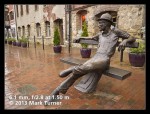
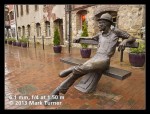
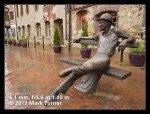

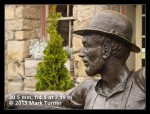
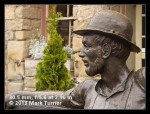
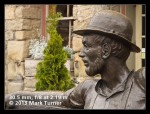



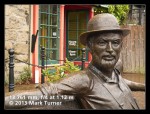
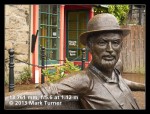
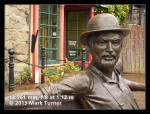
![1300210 Tall Oregon-grape blossoms & foliage [Berberis aquifolium (Mahonia aquifolium)]. Padden Creek Lagoon, Bellingham, WA. © Mark Turner Tall Oregon-grape blossoms & foliage](/wp-content/uploads/2013/04/1300210-150x114.jpg)
![1300211 Tall Oregon-grape blossoms & foliage [Berberis aquifolium (Mahonia aquifolium)]. Padden Creek Lagoon, Bellingham, WA. © Mark Turner Tall Oregon-grape blossoms & foliage](/wp-content/uploads/2013/04/1300211-150x114.jpg)
![1300212 Tall Oregon-grape blossoms & foliage [Berberis aquifolium (Mahonia aquifolium)]. Padden Creek Lagoon, Bellingham, WA. © Mark Turner Tall Oregon-grape blossoms & foliage](/wp-content/uploads/2013/04/1300212-150x114.jpg)
![1300213 Tall Oregon-grape blossoms & foliage [Berberis aquifolium (Mahonia aquifolium)]. Padden Creek Lagoon, Bellingham, WA. © Mark Turner Tall Oregon-grape blossoms & foliage](/wp-content/uploads/2013/04/1300213-150x114.jpg)
![1300214 Tall Oregon-grape blossoms & foliage [Berberis aquifolium (Mahonia aquifolium)]. Padden Creek Lagoon, Bellingham, WA. © Mark Turner Tall Oregon-grape blossoms & foliage](/wp-content/uploads/2013/04/1300214-150x114.jpg)
![1300215 Tall Oregon-grape blossoms & foliage [Berberis aquifolium (Mahonia aquifolium)]. Padden Creek Lagoon, Bellingham, WA. © Mark Turner Tall Oregon-grape blossoms & foliage](/wp-content/uploads/2013/04/1300215-150x114.jpg)
![1300206 Tall Oregon-grape blossoms & foliage [Berberis aquifolium (Mahonia aquifolium)]. Padden Creek Lagoon, Bellingham, WA. © Mark Turner Tall Oregon-grape blossoms & foliage](/wp-content/uploads/2013/04/1300206-150x114.jpg)
![1300207 Tall Oregon-grape blossoms & foliage [Berberis aquifolium (Mahonia aquifolium)]. Padden Creek Lagoon, Bellingham, WA. © Mark Turner Tall Oregon-grape blossoms & foliage](/wp-content/uploads/2013/04/1300207-150x114.jpg)
![1300208 Tall Oregon-grape blossoms & foliage [Berberis aquifolium (Mahonia aquifolium)]. Padden Creek Lagoon, Bellingham, WA. © Mark Turner Tall Oregon-grape blossoms & foliage](/wp-content/uploads/2013/04/1300208-150x114.jpg)
![1300209 Tall Oregon-grape blossoms & foliage [Berberis aquifolium (Mahonia aquifolium)]. Padden Creek Lagoon, Bellingham, WA. © Mark Turner Tall Oregon-grape blossoms & foliage](/wp-content/uploads/2013/04/1300209-150x114.jpg)
![1300223 Kinnickinnick [Arctostaphylos uva-ursi]. Padden Creek Lagoon, Bellingham, WA. © Mark Turner Kinnickinnick](/wp-content/uploads/2013/04/1300223-114x150.jpg)
![1300224 Kinnickinnick [Arctostaphylos uva-ursi]. Padden Creek Lagoon, Bellingham, WA. © Mark Turner Kinnickinnick](/wp-content/uploads/2013/04/1300224-114x150.jpg)
![1300225 Kinnickinnick [Arctostaphylos uva-ursi]. Padden Creek Lagoon, Bellingham, WA. © Mark Turner Kinnickinnick](/wp-content/uploads/2013/04/1300225-114x150.jpg)
![1300226 Kinnickinnick [Arctostaphylos uva-ursi]. Padden Creek Lagoon, Bellingham, WA. © Mark Turner Kinnickinnick](/wp-content/uploads/2013/04/1300226-114x150.jpg)
![1300227 Kinnickinnick blossoms & foliage detail [Arctostaphylos uva-ursi]. Padden Creek Lagoon, Bellingham, WA. © Mark Turner Kinnickinnick blossoms & foliage](/wp-content/uploads/2013/04/1300227-114x150.jpg)
![1300228Kinnickinnick blossoms & foliage detail [Arctostaphylos uva-ursi]. Padden Creek Lagoon, Bellingham, WA. © Mark Turner Kinnickinnick blossoms & foliage](/wp-content/uploads/2013/04/1300228-114x150.jpg)
![1300229 Kinnickinnick blossoms & foliage detail [Arctostaphylos uva-ursi]. Padden Creek Lagoon, Bellingham, WA. © Mark Turner Kinnickinnick blossoms & foliage](/wp-content/uploads/2013/04/1300229-114x150.jpg)